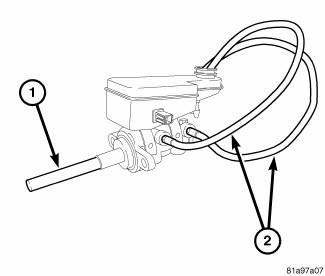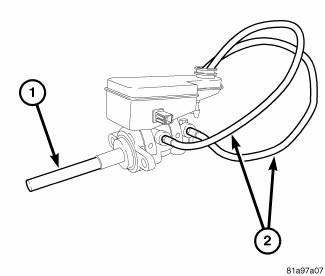Dodge Journey: Standard Procedure
MASTER CYLINDER BLEEDING
1. Clamp the master cylinder in a vise with soft-jaw caps.

Fig. 88: BLEEDING MASTER CYLINDER WITH ABS
2. Thread a Bleeder Tube (2), Special Tool 8358-1, into the primary and secondary ports. Tighten bleeder tube nuts to 17 N.m (150 in. lbs.).
3. Flex each Bleeder Tube and place the open ends into the neck of the master cylinder reservoir. Position the open ends of the tubes into the reservoir so their outlets are below the surface of the brake fluid in the reservoir when filled.
NOTE: Make sure the ends of the Bleeder Tubes stay below the surface of the brake fluid in the reservoir at all times during the bleeding procedure.
4. Fill the brake fluid reservoir with fresh Mopar Brake Fluid DOT 3 Motor Vehicle, or equivalent.

Fig. 89: BLEEDING MASTER CYLINDER WITH ABS
5. Using an appropriately sized wooden dowel as a pushrod (1), slowly press the pistons inward discharging brake fluid through the Bleeder Tubes (2), then release the pressure, allowing the pistons to return to the released position. Repeat this several times until all air bubbles are expelled from the master cylinder bore and Bleeder Tubes.
6. Remove the Bleeder Tubes from the master cylinder and plug the master cylinder outlet ports.
7. Install the fill cap on the reservoir.
8. Remove the master cylinder from the vise.
9. Install the master cylinder on the vehicle.
 Description, Operation
Description, Operation
DESCRIPTION
Fig. 87: PRIMARY AND SECONDARY BRAKE TUBES
All master cylinders (2) are a two-outlet design and the brake tubes from
these primary and secondary outlet
ports lead directly to the In ...
 Removal
Removal
LEFT-HAND-DRIVE
CAUTION: The vacuum in the power brake booster must be depleted
before removing
the master cylinder to avoid damaging the master cylinder and to prevent
inhalation of ...
See also:
Assembly
Fig. 239: Output Shaft #2 & Needle Bearing
1. Install the reverse needle bearing (1) onto the output shaft # 2 (2).
Fig. 240: Synchronizer
NOTE: Pay attention to the direction when inser ...
Removal, Installation
REMOVAL
Fig. 30: Air Inlet Duct
1. Remove air inlet duct (3).
2. Disconnect negative battery cable.
3. Disconnect vacuum hose (1).
4. Remove air filter housing assembly (2).
Fig. 31: R ...
Removal
1. Release the parking brake.
2. Manually release the parking brake cable tension.
3. Raise and support the vehicle.
Fig. 206: TIRE AND WHEEL MOUNTING
4. Remove wheel mounting nuts (3), t ...
